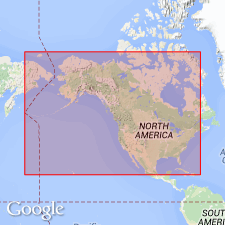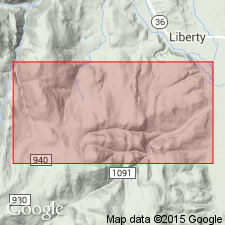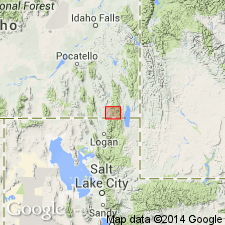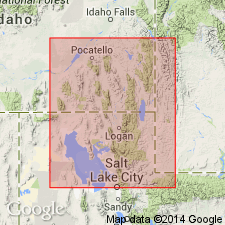
- Usage in publication:
-
- Spence shale*
- Modifications:
-
- Original reference
- Dominant lithology:
-
- Shale
- AAPG geologic province:
-
- Central Western Overthrust
- Wasatch uplift
Summary:
Pg. 5, 6, 8. Spence shale. Argillaceous shales, 30 feet thick west of Liberty, Bear Lake County, southeastern Idaho, and also in Blacksmith Fork, Cache County, northeastern Utah. Basal member of Ute formation. Abundant Middle Cambrian fauna.
Type locality: Spence Gulch, a ravine running up into Danish Flat from Mill Canyon, about 5 mi west-southwest of Liberty, Bear Lake Co., southeastern ID.
[The shale member at base of Howell formation of House Range, Utah, has been correlated by Walcott with Spence shale member of Ute limestone of northeastern Utah. (See p. 183, 197 of vol. cited above.)]
Source: US geologic names lexicon (USGS Bull. 896, p. 2039).

- Usage in publication:
-
- Spence shale member
- Modifications:
-
- Revised
- AAPG geologic province:
-
- Wasatch uplift
Summary:
Pg. 276, 280-281. Spence shale member of Langston formation. Spence shale is not properly a member of Ute formation since it is not present in type locality of the Ute. Furthermore, faunal studies indicate that the shale is lateral facies of dolomite found at base of Langston formation at its type locality. Therefore, the shale is considered to be a member low in Langston formation, not the basal member of Ute formation. [Age is Middle Cambrian.]
Source: US geologic names lexicon (USGS Bull. 1200, p. 3681-3682).

- Usage in publication:
-
- Spence shale member
- Modifications:
-
- Not used
- AAPG geologic province:
-
- Central Western Overthrust
Summary:
Pg. 11-12. Because of the long history of misapplication of the term Spence shale both in the literature and in general use, the advisability of William's and Maxey's usage is questioned, and it is suggested that it [the term] should be dropped.
Source: US geologic names lexicon (USGS Bull. 1200, p. 3681-3682).

- Usage in publication:
-
- Spence Tongue*
- Modifications:
-
- Revised
- AAPG geologic province:
-
- Wasatch uplift
Summary:
Changed from Spence Shale Member to Spence Tongue and reassigned to Lead Bell Shale as its lower tongue (formerly assigned to Ute Limestone). Overlies Naomi Peak Tongue of Twin Knobs Formation and underlies High Creek Limestone. Is recognized on Wasatch uplift in Cache Co., UT. Assigned a Middle Cambrian age.
Source: GNU records (USGS DDS-6; Denver GNULEX).
For more information, please contact Nancy Stamm, Geologic Names Committee Secretary.
Asterisk (*) indicates published by U.S. Geological Survey authors.
"No current usage" (†) implies that a name has been abandoned or has fallen into disuse. Former usage and, if known, replacement name given in parentheses ( ).
Slash (/) indicates name conflicts with nomenclatural guidelines (CSN, 1933; ACSN, 1961, 1970; NACSN, 1983, 2005, 2021). May be explained within brackets ([ ]).

